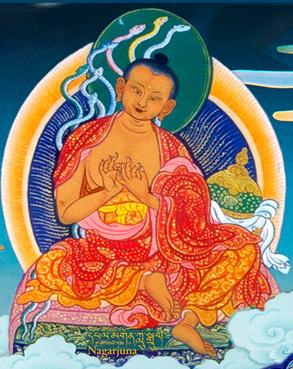Nagarjuna: Difference between revisions
(Sanskrit and Tibetan titles already listed in the entries.) |
No edit summary |
||
| Line 1: | Line 1: | ||
[[Image:Nagarjuna17.JPG|frame]] | [[Image:Nagarjuna17.JPG|frame]] | ||
'''Nagarjuna''' (Skt. ''Nāgārjuna''; Tib. [[ཀླུ་སྒྲུབ་]], ''ludrup'' | '''Nagarjuna''' (Skt. ''Nāgārjuna''; Tib. [[ཀླུ་སྒྲུབ་]], ''ludrup'', [[Wyl.]] ''klu sgrub'') (c.150-250) — one of the six great commentators (the ‘[[Six Ornaments]]’) on the [[Buddha]]’s teachings. The great scholar Nagarjuna is revered as an unsurpassed master by all Buddhist schools. His teachings provide the foundation for the [[Madhyamika]] School, which propounds the ‘Middle Way’ philosophy, accepted as the highest [[view]] within the [[sutrayana]]. He was also the revealer of the [[Prajñaparamita]] [[Sutra]]s, the core teaching of the second turning of the wheel of the Dharma. He is also counted among the [[eighty-four mahasiddhas]], and among the [[eight vidyadharas]]. | ||
[[Dilgo Khyentse Rinpoche]] said: | [[Dilgo Khyentse Rinpoche]] said: | ||
:Noble Nagarjuna was like a second buddha in this world. He composed commentaries explaining all the Buddha’s views. The [[Six Ornaments and Two Supreme Ones]] of the noble land of India asserted that there is no difference between Nagarjuna’s commentaries and the Buddha’s teachings. This is because Nagarjuna’s commentaries cover all three turnings of the wheel as well as the secret-mantra [[vajrayana]]. | :Noble Nagarjuna was like a second buddha in this world. He composed commentaries explaining all the Buddha’s views. The [[Six Ornaments and Two Supreme Ones]] of the noble land of India asserted that there is no difference between Nagarjuna’s commentaries and the Buddha’s teachings. This is because Nagarjuna’s commentaries cover all three turnings of the wheel as well as the secret-mantra [[vajrayana]]. | ||
| Line 31: | Line 30: | ||
==External Links== | ==External Links== | ||
*[http://www.berzinarchives.com/web/en/archives/approaching_buddhism/teachers/lineage_masters/biography_nagarjuna.html A brief biography of Nagarjuna by Alexander Berzin] | *[http://www.berzinarchives.com/web/en/archives/approaching_buddhism/teachers/lineage_masters/biography_nagarjuna.html A brief biography of Nagarjuna by Alexander Berzin] | ||
*{{LH|indian-masters/nagarjuna|Nagarjuna Series on Lotsawa House}} | *{{LH|indian-masters/nagarjuna|Nagarjuna Series on Lotsawa House}} | ||
Revision as of 20:13, 16 December 2018

Nagarjuna (Skt. Nāgārjuna; Tib. ཀླུ་སྒྲུབ་, ludrup, Wyl. klu sgrub) (c.150-250) — one of the six great commentators (the ‘Six Ornaments’) on the Buddha’s teachings. The great scholar Nagarjuna is revered as an unsurpassed master by all Buddhist schools. His teachings provide the foundation for the Madhyamika School, which propounds the ‘Middle Way’ philosophy, accepted as the highest view within the sutrayana. He was also the revealer of the Prajñaparamita Sutras, the core teaching of the second turning of the wheel of the Dharma. He is also counted among the eighty-four mahasiddhas, and among the eight vidyadharas.
Dilgo Khyentse Rinpoche said:
- Noble Nagarjuna was like a second buddha in this world. He composed commentaries explaining all the Buddha’s views. The Six Ornaments and Two Supreme Ones of the noble land of India asserted that there is no difference between Nagarjuna’s commentaries and the Buddha’s teachings. This is because Nagarjuna’s commentaries cover all three turnings of the wheel as well as the secret-mantra vajrayana.
Writings
Collections
| This section contains Tibetan script. Without proper Tibetan rendering support configured, you may see other symbols instead of Tibetan script. |
Nagarjuna's writings mainly employ reasoning in order to clarify the view and the conduct of the Buddhist teachings. His writings are categorized into three collections, corresponding to the three turnings of the wheel of the Dharma. These three collections are:
- Collection of Advice
- Precious Garland -- advice on how to conduct one's life and how to construct social policies that reflect Buddhist ideals.
- Letter to a Friend -- a concise and comprehensive introduction to the entire path and practice of Buddhism.
- Tree of Wisdom -- commentary of manners or moral maxim.
- A Hundred Wisdoms
- Drops for Healing Beings
- Commentary on Bodhichitta
- Anthology or Compendium of Sutras
- Collection of Middle Way Reasoning
- Collection of Praises
Further Reading
- Master of Wisdom, Writings of the Buddhist Master Nagarjuna, translations by Christian Lindtner, Dharma Publishing, 1986
- David Seyfort Ruegg, The Literature of the Madhyamaka School of Philosophy in India, Wiesbaden: Harrassowitz, 1981, pp. 4-49
- Lobsang N. Tsonawa, Indian Buddhist Pandits from The Jewel Garland of Buddhist History, Dharamsala: Library of Tibetan Works and Archives, 1985.
